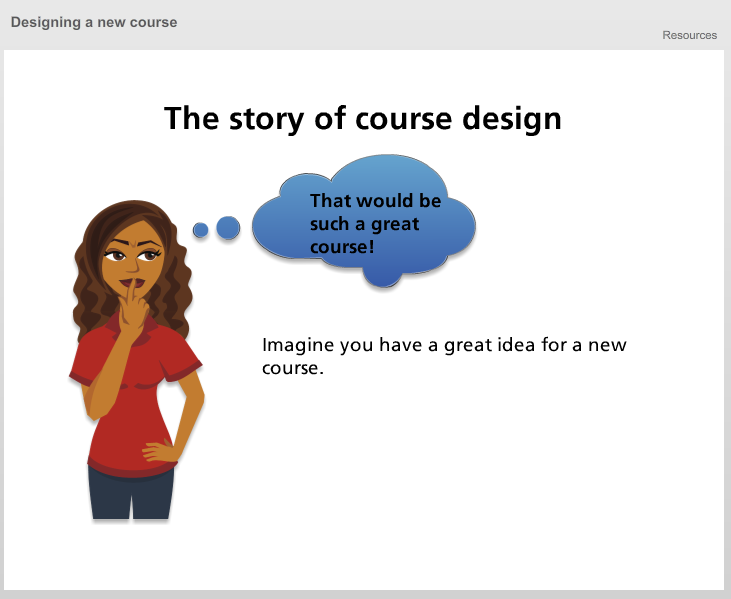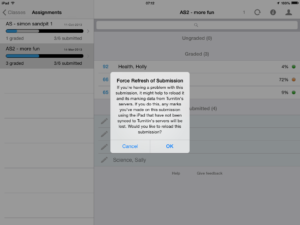 The latest roundup of LearnTech news is now available
The latest roundup of LearnTech news is now available
Learning Designers can provide advice on course design at any time – whether you have a challenge to address in your module, or you’re just looking for new ideas to try. The majority of our work, though, happens when new courses and modules are designed, or existing ones are reviewed. The timeline below looks at the process of creating a new course, and how the Learning Design team fits into it. Click on the image below to launch the timeline:
There is also an overview version available in PDF format.
All sessions have now been mapped to the UK Professional Skills Framework as attendees may include these as evidence for Fellowship applications or ongoing professional development. The NILE Suite has been used to group related sessions together. Where relevant the events have also been mapped to the developing quality standards for NILE sites.
The list below represents the scheduled sessions however they can be run as a bespoke session for three or more staff at any mutually convenient time. All sessions will be run in the Park Library T-Pod (1st Floor) unless stated.
Menu of sessions available:
- Enhancing NILE content using Xerte
- Virtual Classrooms using WizIQ
- Enhancing NILE with media for asynchronous learners
- NILE – Grade Everything (Managing multiple elements in assessment. Marking presentations / live performances)
- The App Cafe
- SaGE Essentials
- SaGE – Providing quality feedback using rubrics
- Managing Groups (and group assignments)
- NILE Essentials – Making the most of your NILE site
- NILE – Encouraging collaboration and NILE interaction using Blogs, Discussion Boards, Journals and Wikis
- NILE – Developing formative assessments in NILE
- Making best use of smartboards
- Increasing in class session interaction using the voting handsets
SaGE Essentials
(Link to the UK PSF – A3, K4)
NILE Suite Alignment: Assessment
This essential session is for both staff who are new to the Submission and Grading Electronically (SaGE) Project and those who need a refresher on the current process. The event will cover the SaGE workflow including marking in Turnitin; passing grades to the NILE grade centre; downloading grades to send to the SATs; and working with the External Examiner. (12 places).
Attendance at this session will assist engagement with the Foundation Quality Standard for NILE sites.
Learning Outcomes:
- Understand the SaGE workflow
- Able to grade work
| Date (s) | Time |
| 20/10/14 | 2-4 |
| 21/10/14 | 2-4 |
| 22/10/14 | 10-12 |
| 23/10/14 | 2-4 (Note this is at Avenue) |
| 24/10/14 | 2-4 |
| 5/11/14 | 2-4 |
| 10/11/14 | 2-4 |
| 20/11/14 | 10-12 |
Register on: https://www.eventbrite.co.uk/e/sage-essentials-tickets-12952281623 for Park based sessions
Register on: https://www.eventbrite.co.uk/e/sage-essentials-tickets-12952410007 for the 23rd October at Avenue Library (MG8a)
SaGE – Providing quality feedback using rubrics
(Link to the UK PSF – A3, K4, V2)
NILE Suite Alignment: Assessment
A dedicated session for those who have already attended the SaGE Essentials session and are confident with the basic SaGE workflow. The event will focus on both Turnitin and NILE rubrics. Rubrics are useful for various styles of marking and can be used for qualitative and quantitative feedback. (12 places).
Learning outcomes:
- Able to setup and use rubrics
| Date (s) | Time |
| 6/11/14 | 10-12 |
Register on: https://www.eventbrite.co.uk/e/sage-providing-quality-feedback-using-rubrics-tickets-12952470187
Managing Groups (and group assignments)
(Link to the UK PSF – A3, K4, V1)
NILE Suite Alignment: Assessment / Collaboration
Regardless of the size of the cohort, the ability to manage groups is an important part of using NILE. Groups allow focused activity, assessment and communication which will enhance student engagement. In addition to learning about the setup and management of groups you will also focus on the NILE assignment submission area which may be used as an alternative to Turnitin submissions. (12 places).
Attendance at this session will assist engagement with the Collaboration Quality Standard for NILE sites.
Learning outcomes:
- Understand how to setup and organise groups
- Appreciate the range of functionality with groups
- Understand how the NILE assignment submission area may be used with groups
| Date (s) | Time |
| 14/11/14 | 2-4 |
Register on: https://www.eventbrite.co.uk/e/managing-groups-and-group-assignments-tickets-12952494259
NILE Essentials – Making the most of your NILE site
(Link to the UK PSF – A4, K4, V2)
NILE Suite Alignment: Content / Management
This session will introduce the NILE sites which are being used for all module and course areas. Find out the Top Ten most common mistakes with existing NILE sites and how to avoid them to improve the student experience. Attendees will develop confidence with working in their NILE area to add new and exciting content. (12 places).
Attendance at this session will assist engagement with the Foundation Quality Standard for NILE sites.
Learning Outcomes:
- Appreciate the range of NILE sites and comon student problems with finding content
- Reflect on your own NILE site based on areas for improvement
- Understand the range of tools to enhance NILE sites
| Date (s) | Time |
| 16/10/14 | 2-4 |
Register on: https://www.eventbrite.co.uk/e/nile-essentials-making-the-most-of-your-nile-site-tickets-12952514319
NILE – Encouraging collaboration and NILE interaction using Blogs, Discussion Boards, Journals and Wikis
(Link to the UK PSF – A2, K2, V1)
NILE Suite Alignment: Collaboration
This session will allow participants to explore the Blogs, Journals, Discussion Boards and Wikis tools inside NILE which encourage greater collaboration. (12 places).
Attendance at this session will assist engagement with the Collaboration Quality Standard for NILE sites.
Learning Outcomes:
- Understand the range of tools available to enhance collaboration within NILE sites
| Date (s) | Time |
| 28/10/14 | 2-4 |
NILE – Developing formative assessments in NILE
(Link to the UK PSF – A3, K4)
NILE Suite Alignment: Assessment
Formative assessment may be used by students to better track their progress and understanding. It may also be used by tutors to ensure that students are engaging and understanding the course material. This session will explore the test, survey and question pool tools within NILE. There is a range of functionality which provides the option of auto marked formative (and summative assessment) with question choices like multiple choice and fill in the blanks. These tools may be used with features such as adaptive release and the performance dashboard to allow greater student interaction with content and a higher level of tutor understanding of student engagement. (12 places).
Attendance at this session will assist engagement with the Participation Quality Standard for NILE sites.
Learning Outcomes:
- Understanding of the range and value of formative assessment
- Appreciate the tools which may be used within formative assessment
- Ability to implement range of appropriate tools within their own course
| Date (s) | Time |
| 17/11/14 | 2-4 |
Register on: https://www.eventbrite.co.uk/e/nile-developing-formative-assessments-in-nile-tickets-12952556445
NILE – Grade Everything (Managing multiple elements in assessment. Marking presentations / live performances)
(Link to the UK PSF – K4, K5)
NILE Suite Alignment: Assessment
This session will explore the NILE Grade Centre where all grades created by students within NILE are held and managed. In addition to being the link between NILE and the Student Record System, this tool allows you to manage the student view of grades, collate grades between assignments (SmartViews) and manage grades and feedback on physical artifacts and performances/presentations. (12 places).
Learning Outcomes:
- Appreciate the functionality available within the Grade Centre
- Understand how the Grade Centre may be used with performances/presentations.
| Date (s) | Time |
| 11/12/14 | 10-12 |
Register on: https://www.eventbrite.co.uk/e/nile-grade-everything-tickets-12952578511
Enhancing NILE with media for asynchronous learners
(Link to the UK PSF – A2, K2, K4)
During this session you will be able to bring along your own ideas for small videos and produce these during the session. Following a short introduction to a range of tools this practical session will encourage you to use these to create material which may be used within existing and planned courses. (12 places).
You will be able to use material which you create within this session within Welcome Sites for new students.
Attendance at this session will assist engagement with the Foundation and Participation Quality Standard for NILE sites.
Learning Outcomes:
- Appreciate the range of tools for asynchronous learners
- Ability to implement tools within their own NILE site.
| Date (s) | Time |
| 15/12/14 | 2-4 |
Register on: https://www.eventbrite.co.uk/e/enhancing-nile-with-media-for-asynchronous-learners-tickets-12952606595
The App Cafe
(Link to the UK PSF – A2, K2, V2)
NILE Suite Alignment: Content / Collaboration
With more and more people accessing the internet via mobile devices, The App Cafe provides an opportunity to look at the implications of mobile devices and apps in HE and how we can better use them in learning and teaching.
We want to hear from you. This is a participative ‘by you, for you’ event with an opportunity each month to share the apps you already use in the classroom with fellow staff across all disciplines.
With take-aways like ‘Your 5-a-month’ (top apps for learning and teaching), coffee and even cake, this is one lunchtime event in LLS you shouldn’t miss.
First Monday of every month (excluding bank holidays)
| Date (s) | Time |
| 6/10/14 | 1-2 |
| 3/11/14 | 1-2 |
| 1/12/14 | 1-2 |
Register on:https://www.eventbrite.co.uk/e/the-app-cafe-tickets-12952837285
Enhancing NILE content using Xerte
(Link to the UK PSF – A2, K2, V2)
Xerte is a great alternative to PowerPoint or Word to enhance basic content in your NILE sites
Xerte can provide rich information and interaction for learners at all levels. You can have a look at an example of material produced in Xerte at: https://xerte.northampton.ac.uk/xertetoolkits/play.php?template_id=118
(12 places).
Learning Outcomes:
- Ability to confidently use Xerte
| Date (s) | Time |
| 12/12/14 | 2-4 |
Register on: https://www.eventbrite.co.uk/e/enhancing-nile-content-using-xerte-tickets-12952921537
Virtual Classrooms using WizIQ
(Link to the UK PSF – A2, K2, V2)
NILE Suite Alignment: Collaboration
WizIQ is an online learning platform / classroom fully integrated into NILE. The rooms are designed to provide an online virtual classroom learning environment to supplement synchronous online activity. (12 places).
Attendance at this session will assist engagement with the Collaboration Quality Standard for NILE sites.
Learning Outcomes:
- Ability to confidently use WizIQ
| Date (s) | Time |
| 4/11/14 | 2-4 |
Register on: https://www.eventbrite.co.uk/e/virtual-classrooms-using-wiziq-tickets-12953078005
Making best use of smartboards
(Link to the UK PSF – A2,K2,K4)
Many opportunities now exist to increase the amount of student interaction within traditional lectures. Smartboards are located in many of the teaching spaces but are often only used to display PowerPoints. This event will introduce the range of tools which allow the Smartboard to ‘come alive’. This event will provide practical experience on using these tools. (12 places).
Learning Outcomes:
- Ability to confidently use the Smartboard
| Date (s) | Time |
| 18/11/14 | 2-4 |
Register on: https://www.eventbrite.co.uk/e/making-best-use-of-smartboards-tickets-12952642703
Increasing in class session interaction using the voting handsets
(Link to the UK PSF – A2, K2, V2)
NILE Suite Alignment: Content / Collaboration
Many opportunities now exist to increase the amount of student interaction within traditional lectures. Voting handsets may be used to increase the amount of feedback students provide within sessions. This event will provide practical experience on using these tools. (12 places).
Learning Outcomes:
- Ability to confidently use the voting handsets
| Date (s) | Time |
| 2/12/14 | 2-4 |
Register on: https://www.eventbrite.co.uk/e/increasing-in-class-session-interaction-using-the-voting-handsets-tickets-12952680817
All of the sessions above and a number of other sessions listed below are also available on request for bespoke events (such as for Subject group training). Please contact your Learning Technologist or mail LearnTech@northampton.ac.uk for details on arranging these.
On Tuesday 2nd September, 2014 at the Association of Learning Technology gala dinner, the Northampton LearnTech team won the award for “Team of the Year 2014”.
The Award’s overall purpose is to celebrate and reward excellent practice and outstanding achievement in the learning technology field and is open to individuals and teams based anywhere in the world.
LearnTech Team - July 2014
Front row (l-r) Rachel Maxwell, Geraldine Murphy, Belinda Green, Rachel McCart. Middle row (l-r) Adel Gordon, Julie Usher, Iain Griffin, Al Holloway, Andy Stenhouse. Back row (l-r) Rob Farmer, Rob Howe, Simon Thompson. Kieran McGovern - not available for photo.
This award recognised the incredible work and progress made by the team over the past few years and the contribution which they have made to the environment within Northampton in addition to advancing the Learning Technology field more generally.
As part of the application process a group of key staff with in the University of Northampton had to talk about the impact which the team had made on their own particular area.
In addition, the team have also had to make a film about the work which they do:
In accepting the award, Rob Howe (Head of Learning Technology) stated that:
“Northampton’s Learning Technology Team is a major force for positive change within the University, its academic partners and the sector. Its institutional role far exceeds supporting colleagues in the use of learning technology: the team fulfils an enabling role, critical to capacity building and scaling up Northampton’s excellent provision. It collaborates with academics and course teams to identify pedagogic needs that appropriate learning technologies can help them address. Through such collaborations, the team embarks on transformational projects leading to innovative and successful experiences across different disciplines and modes of study, as well as research outputs. This is a great achievement not only for the LearnTech team and for Library and Learning Services, but also for the University as a whole.”
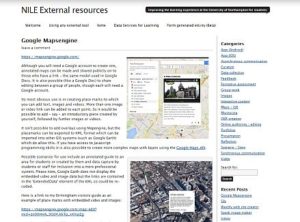 LearnTech has a new resource to help instructors to find resources that exist outside NILE that would improve the student experience. The NILEX blog site contains reviews of external tools and examples of how they might be used. Each tool is tagged to make it easier to find when trying to meet a particular need: displaying maps; asynchronous communication; portfolios; curation; and many others. There is also a full text search facility. We hope that CAIeRO participants will find this a particularly useful resource when they are trying to translate their ideas into activities.
LearnTech has a new resource to help instructors to find resources that exist outside NILE that would improve the student experience. The NILEX blog site contains reviews of external tools and examples of how they might be used. Each tool is tagged to make it easier to find when trying to meet a particular need: displaying maps; asynchronous communication; portfolios; curation; and many others. There is also a full text search facility. We hope that CAIeRO participants will find this a particularly useful resource when they are trying to translate their ideas into activities.
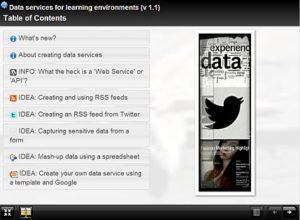 Each tool has been tested in relation to NILE and any integration issues are discussed, along with any registration requirement for staff or students. All the tools are free and licensed to use in education – applications with a ‘paid premium’ element are only included where the free version is of significant use.
Each tool has been tested in relation to NILE and any integration issues are discussed, along with any registration requirement for staff or students. All the tools are free and licensed to use in education – applications with a ‘paid premium’ element are only included where the free version is of significant use.
For instructors interested in the integration of data and data services into their NILE sites (creating ‘mash-ups’ or data for infographics would be examples), a separate module – Data Services for Learners – is included which explains some of the possibilities and includes ideas and examples.
We hope these ideas will help you create new and interesting material that will engage students, as well as new ways for students to collect and present material. New ideas or tools that you think might be included would be very welcome, along with feedback on the content. As external tools often change in their nature and capabilities we do expect them to require updating.
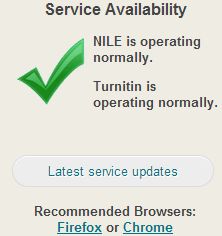 We have updated the service updates link on the NILE welcome page – if you have issues out of hours with NILE this should highlight any problems.
We have updated the service updates link on the NILE welcome page – if you have issues out of hours with NILE this should highlight any problems.
For entries containing the word ‘Link’, the check is a very basic one – does the URL respond with an ‘OK’ status? For all the others an attempt is made to read data from the provider’s service status and give a little more detail. As these vary and this application is new, errors are possible (likely!). There are links to the provider’s feed if this application fails.
If you have any more systems you’d like to be included in a link or better check, please let us know.
NILE was upgraded over the weekend of 16th & 17th August to version 9.1 April 2014. This introduced several new features, the highlights of which are below:
Student Preview
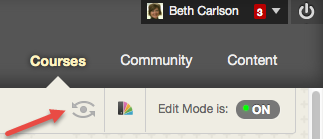
Student Preview
The new Student Preview feature provides Tutors with the capability to see the course exactly how a student would by easily transitioning into and out of a new preview feature.
A new Student Preview button appears in the top right-hand corner of the breadcrumb bar next to the Course Themes and Edit Mode buttons, shaped like an eye.
While in Student Preview mode tutors can interact with the course as if they were a student, including taking quizzes/tests, submitting assignments, posting to forums, posting to blogs, etc.
Upon returning back to the Tutor view any results created while in the preview mode can be retained to allow you to see results– or deleted straight away.
Read more about the Student Preview
Groups Management

Groups Management
Creating groups within NILE, whether small or large, and managing them is now easier. You can choose the students you want to add to a group as well as distinguish among them by viewing their picture and Profile Card. Once a group is created, adding and removing members is just as easy.
Read more about Groups management
Grade Centre Smart Views

Grade Centre Smart Views
When you create a group, you can now simply click a button to create a Smart View in the Grade Centre that corresponds to that group. A Smart View is a focused look at the Grade Centre that is saved for continued use. You can also create and access a group’s Smart View directly from the “All Groups” management page.
Read more about Grade Centre Smart Views
My Grades
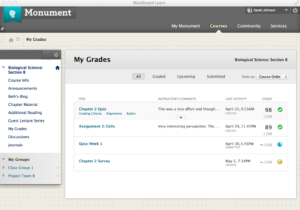
My Grades
The My Grades area where students view their results and feedback has been updated with a new look.
- The presentation of results can be organised – by last activity or due date.
- The “All,” “Graded,” “Upcoming,” and “Submitted” filters allowing students to narrow down the number of rows they see
- The text size and row spacing have been reduced so more information is displayed on the page
- Feedback is included in-line, so students don’t need to click away to view it.
More information on all of the new features
Northampton was previously on Blackboard 9.1 service pack 13 and was upgraded to the April 2014 release. This version moved us two releases above our previous point. (SP14 and April 2014 releases). You can see all the new features which were added as part of the SP14 upgrade and the April 2014 upgrade.
All users of NILE should ensure that browsers are updated to keep within the supported levels.
We hope that you appreciate the new and improved functionality.
An old problem that we hadn’t seen for a long time resurfaced on a couple of course sites last week and – as it is the season for NILE site preparation – may come back to haunt lecturers.
When re-organising your menu on the left of the site, menu items (including dividers and subheadings) begin to refuse to stay where they have been moved to. The symptoms are sometimes not immediately obvious if only one menu item is changed, but as soon as the screen is refreshed the problem is clear.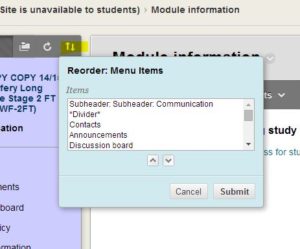
It appears that the Blackboard system can end up with duplicate identifying numbers for menu items when items have been moved around and this can’t be corrected using the drag and drop editor.
The solution is right in front of our eyes, but rarely used. There is an ‘up/down arrow’ icon at the top of the menu when in edit mode – this is the accessible method of re-ordering items. Select the item you want to move and use the arrows to position it. If you alter the ‘bad’ items, this appears to fix the identifying number duplication so you may be able to revert to drag and drop once you’ve used this tool.
![]() On the 4th August Turnitin updated their iPad app to version 1.3.0
On the 4th August Turnitin updated their iPad app to version 1.3.0
The main change that could affect users at Northampton is the ability to force the version of the submission on the server to overwrite that on the iPad. It is unlikely that this will be needed often – perhaps when a submission has been marked using a web browser at the same time that it is being marked on an iPad, or a restored submission needs to be ‘pushed’ to an iPad. A ‘long hold’ on the submission in the iPad brings up a dialog box. Clearly, if you initiate this in error, please cancel to avoid losing any marking you have recently done on your iPad.
This update also mentions ‘grading forms’, a cut down rubric. We don’t recommend these as part of the SaGE process, but there is more information here.
Written by Rebecca Heaton
On 10th July an art and ICT Teach Meet event /art exhibition was held at the Northampton Contemporary Art Gallery showcasing the work of students and local school teachers who have been influenced by the universities Innovation fund projects Stem to SteAm and Technology Outdoors, supported by the School of Education, colleagues from UCEE and the LearnTech team.
The event took the form of an artistic ‘happening’ bringing the outside inside to celebrate a year’s worth of work surrounding the projects. Everyone involved had an enjoyable evening, participants could take part in a number of workshops: light-trails, animation and batik whilst artist Emma Davis created collaborative work in response to the event. To explore and share the evening take a look at the storify created.
Prizes were awarded to many teachers at the event with Bridgewater school winning a set of resources to support iPad use in the curriculum donated by Rising Stars. The school developed a whole school project ‘Bridgecraft’ aligned with the Stem to SteAm agenda. The teachers presenting praised how the university supported and inspired developments in their practice by providing project websites, CPD network groups and media days as part of the innovation projects.
Recent Posts
- Blackboard Upgrade – December 2025
- Preparing for your Physiotherapy Apprenticeship Programme (PREP-PAP) by Fiona Barrett and Anna Smith
- Blackboard Upgrade – November 2025
- Fix Your Content Day 2025
- Blackboard Upgrade – October 2025
- Blackboard Upgrade – September 2025
- The potential student benefits of staying engaged with learning and teaching material
- LearnTech Symposium 2025
- Blackboard Upgrade – August 2025
- H5P (HTML5 package) content types meets the needs of Jim Atkinson, Staff Development Trainer
Tags
ABL Practitioner Stories Academic Skills Accessibility Active Blended Learning (ABL) ADE AI Artificial Intelligence Assessment Design Assessment Tools Blackboard Blackboard Learn Blackboard Upgrade Blended Learning Blogs CAIeRO Collaborate Collaboration Distance Learning Feedback FHES Flipped Learning iNorthampton iPad Kaltura Learner Experience MALT Mobile Newsletter NILE NILE Ultra Outside the box Panopto Presentations Quality Reflection SHED Submitting and Grading Electronically (SaGE) Turnitin Ultra Ultra Upgrade Update Updates Video Waterside XerteArchives
Site Admin

